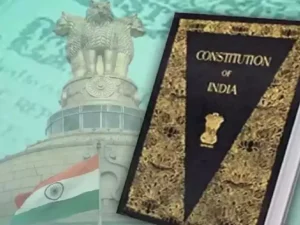
Why in news?
- The Indian Constitution, a meticulously crafted document, strives to balance the ideals of individual liberty (protected by Fundamental Rights) with the nation’s pursuit of social and economic justice (envisioned by Directive Principles of State Policy).
- Article 31C stands at the crossroads of this delicate balance, its very existence a subject of ongoing debate.
What is Article 31C?
- Introduced in 1971 through the 25th Amendment, Article 31C aimed to shield laws enacted to achieve specific social goals from legal challenges based on fundamental rights.
- These goals, outlined in Articles 39B and 39C of the Constitution, focus on:
- Ensuring equitable distribution of a community’s resources for the common good.
- Preventing wealth and means of production from concentrating in the hands of a few, potentially leading to social inequalities.
The Controversy: A Rollercoaster Ride
- The journey of Article 31C has been far from smooth. Here’s a glimpse into the key events that shaped its existence:
- Birth and Partial Demise (1971 & 1973):
- Introduced in response to the Supreme Court’s verdict in the Bank Nationalization Case (1969), Article 31C initially aimed to shield such social welfare initiatives from legal scrutiny.
- However, the Kesavananda Bharati case (1973) established the “basic structure doctrine,” limiting Parliament’s power to amend the Constitution in ways that fundamentally alter its character. A part of Article 31C was struck down, allowing courts to examine if laws enacted under its ambit genuinely aligned with the intended social goals.
- Birth and Partial Demise (1971 & 1973):
-
Attempted Expansion and Reckoning (1976 & 1980): The Constitution (Forty-second) Amendment Act, 1976, aimed to expand Article 31C’s protective cover to encompass all Directive Principles. Additionally, it sought to curtail the judiciary’s power to review amendments. However, the landmark Minerva Mills case (1980) declared clauses related to these aspects unconstitutional, upholding judicial review and raising questions about the continued validity of Article 31C itself.
The Question of Revival: Does Article 31C Still Exist?
- The debate surrounding Article 31C revolves around its current status:
- Argument Against Automatic Revival: Some argue that since the expanded version of Article 31C was struck down, the original version cannot automatically revive. They base this on the legal principle that a replaced provision ceases to exist unless explicitly reinstated.
- Argument for Doctrine of Revival: Others believe the original Article 31C can be revived based on the “doctrine of revival” observed in past cases. They point to instances where struck-down amendments led to the pre-amended provisions resurfacing.
- The Fundamental Rights vs. Directive Principles Conundrum
- Another layer of complexity arises from the potential conflict between Fundamental Rights and Directive Principles. Landmark cases like Champakam Dorairajan (1951), Golaknath (1967), Kesavananda Bharati (1973), and Minerva Mills (1980) have grappled with this issue, establishing the following key principles:
- Fundamental Rights Prevail (Initially): Earlier judgments like Champakam Dorairajan suggested that Fundamental Rights take precedence over Directive Principles in case of conflict.
- Parliament’s Power to Amend with Limits: The Golaknath case initially restricted Parliament’s power to amend Fundamental Rights even for implementing Directive Principles. Later, Kesavananda Bharati overruled this, allowing amendments as long as they didn’t damage the Constitution’s “basic structure.”
- Balancing Act: The Minerva Mills case emphasized the need for a balance between upholding Fundamental Rights and pursuing social justice through Directive Principles. Amendments can be made, but they cannot destroy the Constitution’s core principles.
- Another layer of complexity arises from the potential conflict between Fundamental Rights and Directive Principles. Landmark cases like Champakam Dorairajan (1951), Golaknath (1967), Kesavananda Bharati (1973), and Minerva Mills (1980) have grappled with this issue, establishing the following key principles:
The Way Forward: A Quest for Clarity
- A nine-judge Supreme Court bench recently decided to address the question of Article 31C’s existence while deliberating on a case regarding government acquisition of private property.
- This renewed focus highlights the significance of resolving this ambiguity.
- A clear verdict on Article 31C’s status will have far-reaching implications for the government’s ability to enact legislation aimed at achieving social and economic equality while safeguarding individual rights.
- The judgment is likely to shed light on the delicate interplay between these seemingly contrasting forces within the Indian Constitution.
Conclusion
- The saga of Article 31C exemplifies the ongoing quest for a perfect equilibrium between individual liberty and social progress within the framework of the Indian Constitution.
- The upcoming Supreme Court decision holds the potential to bring much-needed clarity and pave the way for a future where both fundamental rights and social justice goals can be effectively pursued.
People also ask
Q1: What is Article 31C?
Ans: Introduced in 1971, Article 31C aimed to protect laws enacted to achieve social goals like equitable distribution of resources and preventing wealth concentration, from being challenged based on fundamental rights.
Q2: Why is the existence of Article 31C debated?
Ans: A part of it was struck down in 1973, allowing courts to scrutinize if laws aligned with intended social goals. An attempt to expand its scope in 1976 was deemed unconstitutional in 1980, raising questions about Article 31C’s current validity.
Q3: Is Article 31C still in effect?
Ans: There’s no clear answer. Some argue the original version automatically revived, while others believe it needs explicit reinstatement. The Supreme Court is currently examining this issue.
Your point of view caught my eye and was very interesting. Thanks. I have a question for you.